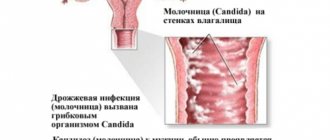About 400 species of different bacteria live in the human intestine. Klebsiella pneumoniae is one of the most common types of opportunistic representatives of normal microflora. The term “opportunistic” means that the microorganism is able to live in the human body for a long time without causing harm. However, under certain conditions (weakened immunity, physical or emotional stress, exacerbation of chronic diseases or acute stage of infection) they are capable of exhibiting their pathogenic properties and causing diseases.
What is Klebsiella pneumoniae?
The bacteria received their name in honor of the German pathologist and microbiologist E. Klebs. Klebsiella is a short, rod-shaped bacteria that inhabits the human intestines, skin and mucous membrane of the lungs. Under natural conditions, they live in soil and water, as well as in plant foods. They do not have flagella, which means they are not capable of movement. They are characterized by a well-defined capsule that protects against the destructive effects of external environmental factors.
In 2020, the World Health Organization added Klebsiella pneumoniae to its list of strains of particular concern because they are resistant to most currently known groups of antibiotics. This fact makes it important to directly identify and conduct a sensitivity test (antibioticogram) to antibiotics before prescribing drugs to the patient. Independent choice of antimicrobial agents leads to increased mutation of bacteria towards the development of additional resistance mechanisms.
Klebsiella pneumoniae can remain viable for a long time on the surface of indoor objects, as well as in water and soil. In dairy products at refrigerator temperatures, they not only do not die, but also continue to actively reproduce. To kill them, exposure to a temperature of at least 65 ° C for at least 1 hour is necessary.
The conditionally pathogenic enterobacteria Klebsiella oxytoca and Klebsiella oxytoca are considered the most common causative agents of klebsiella and pneumonia in humans.
https://youtu.be/pZxRQ5xjNzE
How is Klebsiella transmitted?
You can become infected from a person (sneezing, coughing) in whose body the acute stage of the infectious process develops. Failure to comply with personal hygiene rules increases the risk of infection. It should be noted that sexual transmission of infection is excluded. Large numbers of bacteria can enter through water or undercooked food.
The duration of the incubation period varies from 1 to 7 days. It has been noted that the infection is most pronounced in young children and the elderly, as well as in patients with oncology, since they have rather weak immunity.
Prevention and treatment of Klebsiella pneumonia
Klebsiella pneumonia is an acute inflammation of the lungs, the causative agent of which is the dangerous microorganism of the same name or Friedlander's bacillus. Klebsiella pneumoniae belongs to the Enterobacteriaceae family and has a special capsule that protects it from environmental influences. The microbe is not susceptible to elevated temperatures and is resistant to many antibiotics.
Causes and nature of the disease
There are the following causes of Klebsiella infection:
- weakened immune system;
- too frequent colds;
- prolonged exposure to antibiotics;
- diabetes;
- failure to comply with personal hygiene rules;
- eating contaminated foods (milk, meat, fruits and vegetables);
- airborne infection;
- abuse of alcohol and drugs.
When a bacterium multiplies in the body, it releases large amounts of endotoxin, which causes inflammatory processes in various organs. Often the intestines, urinary system and lungs become victims of the microorganism. Klebsiella pneumonia usually affects weakened organisms that have chronic pathologies of the lungs and bronchi. Very often, the bacterium is diagnosed in the urine of patients undergoing hospital treatment. People who have recently had an organ transplant or undergone chemotherapy are especially susceptible to the disease.
Diagnosis and symptoms of the disease
Typically, Klebsiella pneumonia is detected in a patient's throat swab or stool. A urine test can also detect excessive amounts of the pathogen. Blood samples taken against the background of general intoxication show leukocytopenia and anemia.
During a general examination, an experienced doctor may notice characteristic signs of pneumonia: slight wheezing or muffled percussion sounds. Further X-ray examination confirms lung pathologies, which sometimes involve entire lobes.
However, pneumonia caused by these diseases can be identified by the person themselves based on the characteristic symptoms. These include:
- increased temperature (fever from 37.5° to 39°);
- weakness, sweating, chills;
- blood inclusions in stool and urine;
- cough (at first dry, then with the discharge of purulent sputum interspersed with blood);
- dyspnea.
The incubation period can last from several hours to 7 days. With timely intervention by a doctor, the infection process can be interrupted, but with delayed help, on the contrary, further spread of the infection to other organs and systems is observed. In women, inflammation of the cervical canal of the cervix is possible, as a result of which the reproductive function of the body may be impaired. If a pathogen infection is detected in the urine, you should immediately begin to treat the disease. Otherwise, there is a high probability of death. Therefore, independent treatment with folk remedies is unacceptable.
Features of klebsiellosis in infants
The immune system of young children is extremely susceptible to pneumonia. In some cases, infants are infected while still in the womb. The child’s condition can also be worsened by an additional infection received from the maternity hospital staff. The symptoms of klebsiellosis in infants are similar to the clinical manifestations of dysbacteriosis. The infection manifests itself as follows:
- bloating;
- excessive flatulence and colic;
- belching;
- lethargy and lethargy;
- decreased appetite;
- dehydration;
- loose stools with a pungent odor;
- blood inclusions in urine and feces;
- increase in body temperature.
Pathogenic microorganisms can multiply on the scalp. As a result of their vital activity, tissue necrosis and abscess may develop. Sometimes damage to joints and bone tissue occurs, which is expressed in the form of swelling, stiffness of movement and restless behavior when swaddling.
If an infection is detected in an infant, measures should be immediately taken to remove it from the body. At the slightest delay, surgical treatment in intensive care may be required.
Prevention and treatment of Klebsiella pneumonia
There is no vaccine for this bacterium. As preventive measures, it is recommended to observe hygiene standards, strengthen the immune system with vitamins and a healthy diet, and promptly treat chronic diseases.
Treatment for pneumonia caused by Klebsiella depends on where the infection is located and how severe the symptoms are. Children over 3 years of age with a mild course of the disease can be treated at home under the supervision of a pediatrician. In other cases, all measures are carried out in a hospital, since the infection can spread very quickly.
Patients who are diagnosed with signs of Klebsiella pneumonia are prescribed the following medications:
- intravenous glucose and potassium;
- vitamins of groups B and C;
- probiotics;
- corticosteroids (used for heart damage);
- immunoglobulins;
- tetracycline.
Treatment with antibiotics is used only in the most extreme cases, since further suppression of an already weakened immune system can lead to complications. When diagnosing these in infants, blood transfusions can be used.
There is a high probability of relapses, so it is very important to prevent re-infection.
To do this, you should take measures to strengthen the immune system and treat respiratory diseases in a timely manner.
stronglung.ru
What diseases does Klebsiella cause?
Klebsiella in the intestines begins to actively multiply and exhibit pathogenic properties as a result of taking antibiotics that inhibit the vital activity of symbiotic microflora (preferably bifidobacteria - Klebsiella antagonists). As a result, an exacerbation of chronic gastritis can be provoked - damage to the mucous membrane of the gastrointestinal tract.
Infection with Klebsiella pneumoniae leads to inflammation of the lung tissue (pneumonia). In infants and older people, Klebsiella oxytoca can cause conjunctivitis.
Of particular danger to patients are sepsis (extensive infection of the entire body as a result of pathogenic strains entering the bloodstream) and meningitis (inflammation of the meninges), which can be fatal if medical care is delayed. That is why it is important to isolate the causative agent of the disease as soon as possible, identify it to its species, and then select an adequate treatment regimen.
Read further: Pneumonia - symptoms in adults, children, types, antibiotics for pneumonia
Klebsiella pneumonia: what is it, symptoms, treatment
Opportunistic microflora of the body can be in symbiosis with a person throughout life. But under the influence of provoking factors it can cause infectious diseases. Klebsiella pneumonia or Friendler's bacillus most often enters the body in infancy from the mother or medical staff of the maternity hospital. If the immune system is normal, it will not cause harm. But under certain conditions it can cause serious diseases, including not only pneumonia.
What it is?
Klebsiella pneumoniae is a gram-negative bacterium that can be part of the normal microflora of the respiratory organs, intestines, and skin. When viewed under a microscope, it looks like a stick with rounded edges. The bacteria are immobile and occur singly, in pairs, and in clusters.
The microorganism was first discovered in a patient with pneumonia, hence the name of the bacterium. However, it can cause inflammation not only of the respiratory system, but also of the gastrointestinal tract and genitourinary system. Klebsiella pneumonia is often detected in a smear from the cervical canal in women - this may be normal.
When does a bacterium become pathogenic?
Already on the fifth or sixth day of human life, Klebsiella pneumoniae settles in the microflora of the digestive organs and oral cavity. The norm for bacteria content is in children up to 10 to 5 degrees; in adults, the permissible value is usually lower. If the throat smear or stool test reaches klebsiella pneumoniae 10 to 6 degrees or more, then the microorganism is considered pathogenic.
Various factors can provoke such active proliferation of bacteria:
- Reduced immunity (especially typical for newborns and the elderly).
- Diabetes.
- Avitaminosis.
- Systematic intake of alcohol.
- Dystrophy.
- Conditions after organ transplantation.
- Disruption of normal microflora as a result of taking antibiotics to which Klebsiella is insensitive.
An increase in the number of pathogens is accompanied by an abundant release of toxic substances, which cause inflammation.
The main route of transmission of bacteria is airborne droplets. But Klebsiella pneumoniae lives in the soil for a long time, so we cannot exclude the possibility of it entering the body from dirty hands and poorly processed food.
The development of diseases can be associated both with the growth of one’s own pathogenic microflora, and with the penetration of new bacteria from the outside.
The microorganism can mutate and become the cause of nosocomial infection. Treating the disease in this form is much more difficult because these bacteria are often not susceptible to common antibiotics.
What diseases does it cause?
Localization and reproduction of bacteria in individual organs and systems can provoke various diseases with characteristic symptoms. Most often, Klebsiella pneumonia causes pneumonia, but can affect the nasopharynx, gastrointestinal tract and genitourinary system.
In the lungs
The proliferation of bacteria in the lower respiratory tract contributes to the development of Klebsiella pneumonia. This is a fairly rare type of disease. Of all cases of pneumonia caused by klebsiella pneumoniae, it accounts for only 3%.
Klebsiella pneumonia develops rapidly; several foci of inflammation can form in the lungs in a short period of time. Due to the complexity of treatment due to the bacteria's resistance to many antibiotics, the mortality rate from this type of pneumonia reaches 30%.
The incubation period can vary from several hours to several weeks. Symptoms arise abruptly and are pronounced.
Signs of klebsiella pneumonia (chlamydial pneumonia has similar symptoms):
- Headache.
- Chills.
- Increased body temperature.
- Pain in the lungs and throat.
- Intoxication, which is expressed by apathy, drowsiness, nausea, vomiting.
- Wheezing in the lungs when breathing.
- Cough, shortness of breath.
- Discharge of sputum with a putrid odor and streaked with blood.
In the first stages, the disease is expressed as an acute respiratory infection; serious symptoms appear when pneumonia has already gained strength. In advanced cases, necrosis of the lung tissue occurs and inflammation spreads to other organs. The set of symptoms is identical to pneumonia, which is caused by chlamydia and other microorganisms, so an accurate diagnosis can only be made after clinical studies.
In the upper respiratory tract
When the bacteria spreads in the nasopharynx and upper respiratory tract, the symptoms are less varied than with pneumonia. The development is also acute, the incubation period is several days or hours. Signs of damage:
- Congestion of the nasal passage and sinuses.
- Discharge from the nose (purulent with an unpleasant odor).
- Atrophy of the mucous membranes.
- Rash on the mucous membranes of the throat caused by the formation of granulomas.
- Cough with mucous discharge.
- A sore throat.
Lack of timely treatment leads to the spread of inflammation to the lungs and the development of chronic diseases of the nasopharynx.
In the gastrointestinal tract
The proliferation of bacteria in the digestive organs is often associated with the use of antibiotics that destroy normal microflora. When the permissible value in the stool of Klebsiella pneumonia is exceeded to 10 to 6 degrees, gastritis, dysbacteriosis, and gastroduodenitis occur. The development is acute. Possible symptoms:
- Nausea, vomiting.
- Pain in the abdominal area.
- Increased body temperature.
- Weakness.
- Loose stools.
- Bloody and mucous inclusions in the stool.
Often the condition quickly returns to normal, but in some cases it is possible to introduce infection into the lungs and nasopharynx with vomit.
In the urinary tract
Normally, the bacterium Klebsiella pneumoniae is not found in urine. If it is found during tests, then it is pathogenic. Of all cases of urinary tract infections, 6–9% are caused by this microorganism.
Symptoms are nonspecific:
- Impaired urinary function.
- A feeling of pain and heaviness in the lumbar region, radiating to the side.
- Temperature increase.
Lack of treatment leads to the development of pyelonephritis, cystitis, prostatitis and other diseases of the genitourinary system.
Treatment
The medication is prescribed by the attending physician, taking into account the location of the lesions, the presence of complications and the age of the patient. The choice of treatment tactics occurs after collecting anamnesis and taking tests:
- Throat and nose swab.
- General blood test.
- X-ray of the lungs.
- Stool and urine examinations.
The main therapeutic effect in adults is achieved by taking antibiotics, to which Klebsiella pneumoniae is sensitive - this is the most effective method of combating the disease, despite the fact that sometimes difficulties arise with the choice of drug.
In children, treatment methods are more gentle: taking bacteriophages and probiotics, which selectively destroy klebsiella pneumoniae, but at the same time less effective.
In addition to the main treatment, medications are prescribed:
- removing toxins;
- expectorants;
- immunomodulatory.
If you consult a specialist in a timely manner, the prognosis is favorable; in advanced cases, complications and relapses may develop. The most difficult thing to cope with is pneumonia. Klebsiella pneumonia, like chlamydial pneumonia, requires long-term treatment in a hospital setting.
Klebsiella pneumonia is part of the normal human microflora, but under certain conditions it can lead to the development of serious pathologies, including death. If bacteria grow to values higher than normal, immediate treatment must be taken.
AUTHOR OF THE ARTICLE ALEXEEV Sergey Semenovich parasitologist 49 questions
ASK A QUESTION
oparazitah.com
Symptoms of infection
Symptoms of Klebsiella infection in infants and adult patients are similar, however, they may differ in the severity of the manifestations. Thus, in children, the manifestation of the disease is characterized by an acute manifestation. Signs of the disease vary depending on the location of the infection.
Symptoms of pneumonia
The main manifestations of the disease include:
- fever, body temperature reaches 39 ° C;
- general weakness, decreased performance, drowsiness, shortness of breath;
- At the first stages, the cough is dry, however, it gradually turns into a wet cough with purulent discharge and blood clots.
It is important to correctly diagnose pneumonia and differentiate it from other lung diseases with a similar etiology. The X-ray image shows inflamed foci of the affected areas of the lung tissue. In most cases, infection begins in the upper sections and then moves down to the lower sections. The disease does not tolerate delay in prescribing treatment, since mortality statistics reach 36% of the total number of sick patients. Often, pneumonia is complicated by the addition of a secondary infection, followed by sepsis and damage to all organs.
Symptoms of damage to the gastrointestinal tract
Klebsiella pneumoniae can also cause gastritis, enteritis or enterocolitis with characteristic symptoms:
- acute pain in the abdominal area;
- heartburn and nausea;
- weight loss due to decreased appetite;
- general weakness and drowsiness;
- loose stool mixed with blood or mucus, with an unnatural foul odor.
It was noted that the duration of the acute stage does not exceed 5 days. Throughout the entire period, Klebsiella is detected in stool analysis in adults and children.
Symptoms of urinary tract infection
Bacteria from the genus Klebsiella can cause inflammatory diseases of the urinary and reproductive systems - cystitis, prostatitis or pyelonephritis. Each pathology has a typical manifestation pattern; general symptoms include:
- a sharp increase in daily diuresis - the amount of urine excreted;
- painful urination;
- urine mixed with blood;
- pain in the lower abdominal region;
- increase in body temperature.
The presence of at least one of the above symptoms is a sufficient reason to consult a doctor and conduct a comprehensive examination.
Sepsis is a threat to life
The condition of sepsis is very dangerous, especially for young patients and people with severe chronic pathologies. Klebsiella pneumoniae is capable of secreting toxins that provoke a toxic shock reaction. In addition, with sepsis, this type of bacteria causes a disruption in the blood supply to individual organs and systems due to damage to blood vessels and capillaries.
Most often, sepsis is the result of an advanced infectious process without the timely selection of antibacterial drugs. Treatment should be carried out in a hospital inpatient setting under 24-hour medical supervision.
Treatment
The treatment regimen is determined individually and depends on the severity of the patient’s disease. Most often, bacteriophages are used in combination with antibiotics. This treatment does not harm the normal flora. If such a complex is ineffective, antibacterial agents are used. Most often, treatment takes place at home; hospitalization is a last resort and is provided when the victim’s well-being rapidly deteriorates.
The list of indications for hospitalization includes:
- prolonged increase in body temperature;
- symptoms of acute intoxication of the body;
- signs of sepsis.
Attention! The duration of treatment depends on the extent of the damage.
Klebsiella in a baby's stool
At the first symptoms of infection, parents should immediately consult a doctor with their child, since Klebsiella causes an acute infectious process in infants. Diagnostics consists of several stages. First, the doctor examines the child and collects a general history taking into account symptoms. The second stage is laboratory diagnostics, which consists of sowing biomaterial (stool) onto nutrient media followed by cultivation. Additionally prescribed: blood test, coprogram, test for dysbacteriosis.
It is important to correctly interpret the results, since Klebsiella pneumoniae is part of the normal microflora and can be excreted in small quantities in urine or feces.
Klebsiella pneumonia in the feces of an infant at a concentration of more than 105 per 1 g of the test material indicates the need to select antibacterial agents. It is important to consider the age of the child, since most antibiotics have a minimum age for use. Neglecting this rule will lead to a deterioration in the child’s condition and complicate therapy, so only the attending physician can select medications based on the results of tests and an antibiogram.
Symptoms
Klebsiella pneumoniae was originally classified as a type of microorganism that causes pneumonia. Bacteria of this type are localized on the mucous membranes of various organs and systems, and therefore provoke a variety of diseases that are different from each other.
Lungs
Klebsiella pneumonia is considered dangerous in terms of symptoms and course of the disease. Foci of inflammation are located in the lower parts of the lungs. The disease begins as a common acute respiratory infection. Inflammation develops quickly and occurs in an acute form. The following symptoms occur:
High fever and weakness
- fever and increased body temperature to high levels;
- cough and shortness of breath;
- signs of intoxication (dizziness, vomiting, weakness);
- wheezing in the lungs;
- pain in the chest;
- sputum with bloody streaks and an unpleasant odor.
When the bacterium infects the nasopharynx, the symptoms are as follows:
- runny nose;
- sore throat;
- atrophy of the mucous membranes;
- cough with sputum.
If you do not start timely and correct treatment, there is a risk of pneumonia.
Gastrointestinal tract
Friedlander's wand can cause the following diseases:
Gastritis
- gastritis;
- enteritis;
- enterocolitis.
The symptoms are similar in each case. The patient develops:
- vomit;
- loose stools;
- abdominal pain;
- weakness;
- drowsiness;
- dehydration.
Klebsiella pneumonia is diagnosed primarily by stool analysis. In the acute phase, the disease lasts no longer than 5 days with proper treatment.
urinary system
When the Klebsiella bacterium is found in a patient’s urine, this indicates an inflammatory process of the pelvic cavity. Symptoms in this case may be as follows:
Pain in the lower abdomen
- pain in the lower abdomen;
- pain when urinating;
- increasing the daily norm of fluid secreted;
- blood in the urine;
- increased body temperature;
- discharge from the genitals.
During the inflammatory process caused by a pathogenic microorganism, complications may develop:
- cystitis;
- pyelonephritis;
- prostatitis.
The most dangerous thing is sepsis. This is a state of real threat for an adult and, of course, for a child.
Sepsis
During pregnancy, women should be wary of Friedlander's wand. The peculiarity of the bacterium is that it easily penetrates the placenta and causes serious damage to the baby’s intrauterine development. If a woman in labor begins to experience inflammation in the mucous membrane of the birth canal, then after birth the baby may immediately develop pneumonia.
Klebsiella pneumonia releases substances that can lead to toxic shock. Timely and adequate therapy stops the development of pathogenesis reactions and helps to avoid complications.
Klebsiella pneumonia in urine
For a long time, scientists agreed that urine is sterile. However, research in recent decades provides compelling evidence to refute this dogma. In most cases, representatives of enterobacteria (Escherichia coli, Klebsiella, Proteus) are isolated from urine. It is important that their number does not exceed single cells when grown on a nutrient medium.
Klebsiella in the urine may indicate an infection of the urinary system, as well as extensive sepsis of the whole body.
Klebsiella pneumonia in smear
When lesions of the upper respiratory tract are detected, a smear is taken from the throat, and to diagnose infection of the genital organs in women, a smear is taken from the cervical canal. Normally, the genus of bacteria in question should be absent from the smears examined. Microscopy of the resulting preparation is carried out, as well as sowing of the taken biomaterial on nutrient media.
Read further: Interpretation of flora culture with determination of sensitivity to antibiotics
Clinical picture of the development of Klebsiella
The disease develops for the following reasons:
- the body's protective functions are reduced;
- failure to comply with basic hygiene rules;
- chronic colds;
- uncontrolled use of antibiotics for a long time;
- diabetes;
- use of alcohol or drugs.
With pronounced symptoms, the human body can become severely intoxicated.
The disease affects all respiratory organs; in the absence of timely assistance, the patient develops foci of inflammation in the lungs. This will be followed by partial death of lung cells. This rapidity in development is explained by the ability of the disease to damage tissue.
The inflammatory process can form in the bones, lining of the brain, urinary system and intestines. With a long and chronic course of this disease, death cannot be ruled out.
Bacteria have the ability to reproduce. This phenomenon is especially common in patients over 60 years of age. Due to the weakening of the body's immune functions, the bacterium can cause the development of pneumonia.
Sometimes Klebsiella pneumonia appears in a smear from the cervical canal. If there are no visible symptoms, a throat swab should be taken.
Main symptoms of the disease:
- feeling of weakness, general malaise;
- aching headaches;
- feverish attacks and chills;
- inflammation of the tonsils;
- periodic tingling and pain in the side, with intense breathing.
The main symptom of the disease is a cough with the release of blood clots along with sputum.
The inflammatory process of the respiratory system is accompanied by the following symptoms:
- protracted course of the disease;
- rapid development of inflammation;
- sharp pain attacks;
- when coughing, sputum with an unpleasant odor is produced;
- damage to the body by toxins.
Due to damage to the nasal mucosa, a person develops a runny nose with purulent discharge. This purulent secretion is difficult to drain, causing the nasal cavity to close with crusts. Then the patient's body temperature may rise sharply.
Klebsiella during pregnancy
For pregnant women, infection with Klebsiella pneumoniae poses a danger to the normal bearing of a child. Bacteria are able to penetrate the placental barrier and infect the baby, provoking various mutations and insufficient blood supply due to the toxins released. Klebsiella in urine, feces or smears in concentrations exceeding permissible values indicates an infectious infection.
It is important for pregnant women to undergo routine examinations and take all tests on time. The choice of antibiotics is difficult due to the restrictions of most drugs for use in the first trimesters of pregnancy. An alternative for the expectant mother could be medications based on bacteriophages - viruses that selectively destroy certain types of bacteria. The treatment regimen, its duration and daily doses are selected exclusively by the attending physician based on a comprehensive examination.
How dangerous is the disease during pregnancy?
While the body of a healthy woman with strong protective functions can still overcome this infection, this is impossible during pregnancy. Klebsiella pneumonia in a smear during pregnancy shows the presence of the bacterium; the inflammatory process usually occurs in an acute form.
If untimely or incorrectly treated, the disease can cause serious complications for the mother and child, because the respiratory system is affected, the work of which allows oxygen to enter the blood.
It is not recommended to use antibiotics in the first trimester of pregnancy, so if the disease is prolonged, irreversible mutations in the fetus may occur.
The possibility of prescribing an abortion for a woman with an infection cannot be ruled out.
Bacteriophages are used for treatment, which cannot in any way affect the fetus, but the effectiveness of these drugs is much lower than that of antibiotics.
The presence of Klebsiella often causes spontaneous abortion. Thus, some women regularly experience miscarriages. To exclude this possibility, it is necessary to conduct an examination of both women and men.








